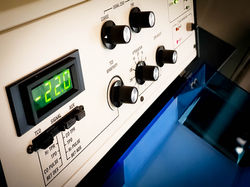RESEARCH LAB

SPECIAL LAB EQUIPMENT RESEARCH
HT/HP Reactors 4857 series by Parr
Operating conditions up to 3000 PSI and 800 ° C in stainless steel with optional stirring.
One of the main fields of experimentation is to test different attributes under varying conditions such as (heating, cooling, pressure and stirring speed) These results allow its reproducibility.
This equipment has allowed us to know among other things the presence of atomic hydrogen dissolved in wáter, reacting with other refractory compounds such as N2 and CO2.
The digital control of the tests allows us to reproduce the fundamental conditions of experimentation and the information statistical management.
Gas Chromatograph Coupled to a Mass Spectrometer
The mass spectrometry technique helps to identify the amount and type of chemical compound measuring the mass / charge ratio and the abundance of ions in the gas phase.
With this technique we identify the chemical structures of volatile and semi-volatile compounds lower than the 350 ° C obtained from the experimentation of transformation processes such as incondensable gases, naphthas, gas oils, diesel and gasoline.
Chemisorption ChemBET Pulsar TPR/TPD
This Chemical Adsorption highly specialized technique within the catalysts experimentation, allows to obtain adsorption isotherms, gas pulses valuations, monolayer capacity, metallic área, crystal size, metal dispersión, etc.
These values allow to "visualize" the active surfaces of the catalysts, the complex relationship between metal and metals, eutectic point and its manipulation to promote the physical reactions of transformation that allow to achieve the atomic hydrogen generation and its simultaneous or integrated reaction with the heteroatoms, molecules saturation and until the hydrocarbon molecules ionization, particularly in heavy crude oils.
The atomic hydrogen is infinitely more unstable than the molecular hydrogen, which allows reactions without pressure and additional catalysts.
Hydrogen, Carbon Monoxide and Oxygen are some of the most used gases to quantitatively assess the number of active sites on their surface by Redox reactions.
Catalytic Pyrolysis Pilot Plant Equipment
Through REEC Catalytic Pyrolysis Technology, we have a pilot plant with a unique and patented design in which by the hydrogen addition in atomic state we improve the quality of heavy crude oils. transforming them into high value-added products for the oil, gas, refining and petrochemical industries.
In the main chemical reaction of simultaneous Generation/Reaction in an Integrated process, reactions are achieved such as: Controlled Cracking, Hetereoatomes Reaction/Elimination, molecules saturation and ionization.
As a final result, simpler molecules of saturated and ionized hydrocarbons such as: Middle fractions mainly, aliphatic, cyclic hydrocarbons and olefins.
The Catalytic Pyrolysis Process patented by REEC is carried out at atmospheric pressure, so this means lower operating costs compared to current refining technologies.
Packed Columns and Steam Injection (Catalytic Pyrolysis Solvent Test)
With the Packed Columns and Steam Injection test, the oil well production parameters are simulated, based on oil field formation conditions data.
Improve the reservoir production in different conditions using the REEC Catalytic Pyrolysis Solvent, it is one of the technologies on which this process is based.
Experiments are carried out to measure the material permeability capacity after injecting our Catalytic Pyrolysis Solvent and allow increased production levels with higher value-added products.
The process involves important factors such as: Pressure, Temperature and Time.
 |
|---|
 |
 |
 |
 |
 |
 |
 |
|---|
 |
 |
 |
 |
 |
 |
|---|
 |
 |
 |
 |
 |
 |
 |
 |
|---|
 |
 |
 |
 |
 |
 |
 |
 |
 |
 |
|---|
 |
 |
 |



















